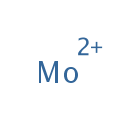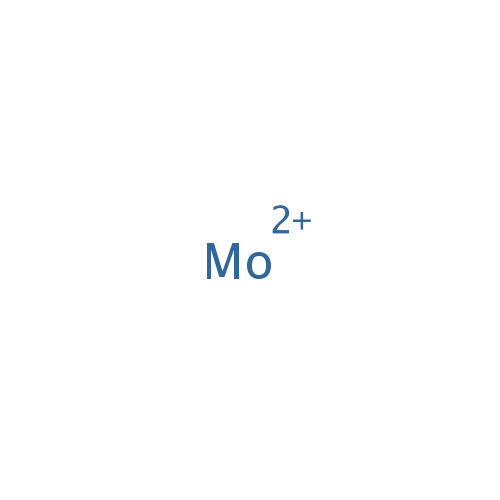|
Record Information |
|---|
| Version |
1.0 |
|---|
| Update Date |
1/22/2018 11:54:54 AM |
|---|
|
Metabolite ID | PAMDB001785 |
|---|
|
Identification |
|---|
| Name: |
Molybdenum |
|---|
| Description: | Molybdenum is a transition metal with the atomic symbol Mo, atomic number 42, and atomic weight 95.94. The pure metal is silvery white in color, fairly soft, and has one of the highest melting points of all pure elements. Physiologically, it exists as an ion. It is an essential trace element, being a component of the enzymes xanthine oxidase, aldehyde oxidase, and nitrate reductase. There is a trace requirement for molybdenum in plants, and soils can be barren due to molybdenum deficiencies. Plants and animals generally have molybdenum present in amounts of a few parts per million. In small quantities, molybdenum is effective at hardening steel. Molybdenum is important in plant nutrition, and is found in certain enzymes, including xanthine oxidase. Molybdenum is used to this day in high-strength alloys and in high-temperature steels. Special molybdenum-containing alloys, such as the Hastelloys, are notably heat-resistant and corrosion-resistant. Molybdenum is used in oil pipelines, aircraft and missile parts, and in filaments. Molybdenum finds use as a catalyst in the petroleum industry, especially in catalysts for removing organic sulfurs from petroleum products. It is used to form the anode in some x-ray tubes, particularly in mammography applications. And is found in some electronic applications as the conductive metal layers in thin-film transistors (TFTs). Molybdenum disulfide is a good lubricant, especially at high temperatures. And Mo-99 is used in the nuclear isotope industry. Molybdenum pigments range from red-yellow to a bright red orange and are used in paints, inks, plastics, and rubber compounds. |
|---|
|
Structure |
|
|---|
| Synonyms: | - Mo
- Molybdaen
- Molybdene
- Molybdenum atom
- Molybdenum elemental
- Molybdenum insoluble compounds
- Molybdenum metallic
- Molybdenum(2+)
|
|---|
|
Chemical Formula: |
Mo |
|---|
| Average Molecular Weight: |
95.94 |
|---|
| Monoisotopic Molecular
Weight: |
97.905407846 |
|---|
| InChI Key: |
MMVYPOCJESWGTC-UHFFFAOYSA-N |
|---|
| InChI: | InChI=1S/Mo/q+2 |
|---|
| CAS
number: |
7439-98-7 |
|---|
| IUPAC Name: | molybdenum(2+) ion |
|---|
|
Traditional IUPAC Name: |
molybdenum(2+) ion |
|---|
| SMILES: | [Mo++] |
|---|
|
Chemical Taxonomy |
|---|
|
Taxonomy Description | This compound belongs to the class of inorganic compounds known as homogeneous transition metal compounds. These are inorganic compounds containing only metal atoms,with the largest atom being a transition metal atom. |
|---|
|
Kingdom |
Inorganic compounds |
|---|
| Super Class | Homogeneous metal compounds |
|---|
|
Class |
Homogeneous transition metal compounds |
|---|
| Sub Class | Not Available |
|---|
|
Direct Parent |
Homogeneous transition metal compounds |
|---|
| Alternative Parents |
Not Available |
|---|
| Substituents |
- Homogeneous transition metal
- Acyclic compound
|
|---|
| Molecular Framework |
Acyclic compounds |
|---|
| External Descriptors |
|
|---|
|
Physical Properties |
|---|
| State: |
Solid |
|---|
| Charge: | 2 |
|---|
|
Melting point: |
2622 °C |
|---|
| Experimental Properties: |
|
|---|
| Predicted Properties |
|
|---|
|
Biological Properties |
|---|
| Cellular Locations: |
Cytoplasm |
|---|
| Reactions: | |
|---|
|
Pathways: |
Not Available |
|---|
|
Spectra |
|---|
| Spectra: |
|
|---|
|
References |
|---|
| References: |
- Barceloux DG: Molybdenum. J Toxicol Clin Toxicol. 1999;37(2):231-7. Pubmed: 10382558
- Enemark JH, Astashkin AV, Raitsimring AM: Investigation of the coordination structures of the molybdenum(v) sites of sulfite oxidizing enzymes by pulsed EPR spectroscopy. Dalton Trans. 2006 Aug 7;(29):3501-14. Epub 2006 Jun 22. Pubmed: 16855750
- Failla ML: Considerations for determining 'optimal nutrition' for copper, zinc, manganese and molybdenum. Proc Nutr Soc. 1999 May;58(2):497-505. Pubmed: 10466195
- Goldhaber SB: Trace element risk assessment: essentiality vs. toxicity. Regul Toxicol Pharmacol. 2003 Oct;38(2):232-42. Pubmed: 14550763
- Hille R: Molybdenum and tungsten in biology. Trends Biochem Sci. 2002 Jul;27(7):360-7. Pubmed: 12114025
- Hille R: Molybdenum-containing hydroxylases. Arch Biochem Biophys. 2005 Jan 1;433(1):107-16. Pubmed: 15581570
- Johnson JL: Prenatal diagnosis of molybdenum cofactor deficiency and isolated sulfite oxidase deficiency. Prenat Diagn. 2003 Jan;23(1):6-8. Pubmed: 12533804
- Kisker C, Schindelin H, Baas D, Retey J, Meckenstock RU, Kroneck PM: A structural comparison of molybdenum cofactor-containing enzymes. FEMS Microbiol Rev. 1998 Dec;22(5):503-21. Pubmed: 9990727
- Kisker C, Schindelin H, Rees DC: Molybdenum-cofactor-containing enzymes: structure and mechanism. Annu Rev Biochem. 1997;66:233-67. Pubmed: 9242907
- Kitamura S, Sugihara K, Ohta S: Drug-metabolizing ability of molybdenum hydroxylases. Drug Metab Pharmacokinet. 2006 Apr;21(2):83-98. Pubmed: 16702728
- Mendel RR, Bittner F: Cell biology of molybdenum. Biochim Biophys Acta. 2006 Jul;1763(7):621-35. Epub 2006 May 12. Pubmed: 16784786
- Mendel RR: Molybdenum: biological activity and metabolism. Dalton Trans. 2005 Nov 7;(21):3404-9. Epub 2005 Sep 26. Pubmed: 16234918
- Nakagawa N: [Studies on changes in trace elements of the brain related to aging] Hokkaido Igaku Zasshi. 1998 Mar;73(2):181-99. Pubmed: 9612711
- Reiss J, Johnson JL: Mutations in the molybdenum cofactor biosynthetic genes MOCS1, MOCS2, and GEPH. Hum Mutat. 2003 Jun;21(6):569-76. Pubmed: 12754701
- Reiss J: Genetics of molybdenum cofactor deficiency. Hum Genet. 2000 Feb;106(2):157-63. Pubmed: 10746556
- Schmidt M, Weber H, Schon R: Cobalt chromium molybdenum metal combination for modular hip prostheses. Clin Orthop Relat Res. 1996 Aug;(329 Suppl):S35-47. Pubmed: 8769321
- Schwarz G: Molybdenum cofactor biosynthesis and deficiency. Cell Mol Life Sci. 2005 Dec;62(23):2792-810. Pubmed: 16261263
- Vyskocil A, Viau C: Assessment of molybdenum toxicity in humans. J Appl Toxicol. 1999 May-Jun;19(3):185-92. Pubmed: 10362269
- Williams RJ, Frausto da Silva JJ: The involvement of molybdenum in life. Biochem Biophys Res Commun. 2002 Mar 29;292(2):293-9. Pubmed: 11906160
|
|---|
| Synthesis Reference: |
Not Available |
|---|
| Material Safety Data Sheet (MSDS) |
Download (PDF) |
|---|
|
Links |
|---|
| External Links: |
|
|---|


